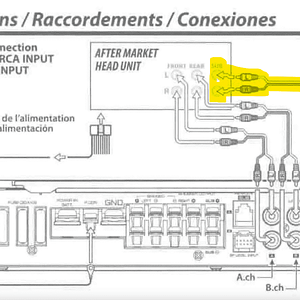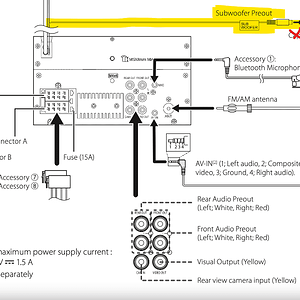You are using an out of date browser. It may not display this or other websites correctly.
You should upgrade or use an alternative browser.
You should upgrade or use an alternative browser.
-
24Participant count
-
Participant list
n2caraudio 10+ year member
Senior VIP Member
True, nothing if more fun than midget tossing.More fun than midget tossing AND elephant rides?!? Not a chance. One or the other, not both.
lostdaytomorrow 10+ year member
CarAudio.com Elite
n2caraudio 10+ year member
Senior VIP Member
keep_hope_alive Premium Member
Acoustics Engineer
i've been busy, not avoiding this. i think we can bring this back to a civil conversation. you bring up excellent points but i still see that you are missing some of what i'm trying to say. the problem with educated people having a discussion about technical concepts is that we get caught up in semantics and it takes some bantering before we realize we're trying to say the same thing.
My argument is false if, and only if, there is no resistance between ground points on the chassis of an automobile in use. When the car is off, we don't care. When the battery is disconnected, we don't care.
we were talking about the validity and purpose of fusing grounds in an automobile. that was the purpose of this thread and we all agree on this. I got on a side topic regarding noise as a result of resistance in the chassis and that caused disagreement, i think, because of interpretations of my use of the phrase "difference in potential". maybe the term "electrical potential difference" sits with you better? if you prefer different terminology let me know.
there is resistance between each battery terminal and the load. even if the load is connected directly to the battery - there is resistance in the connections. the voltage between terminals at the load is less than the voltage between terminals at the battery - how much less depends on current and resistance of each path. simple ohm's law. work is done as charge "flows" from point A to point B. this means there is an electrical potential difference between any two points of either path. all this is measurable. we shouldn't be arguing any of this.
yes, the vehicle chassis is essentially a giant bus bar. a buss bar has resistance per unit length. bus bars have voltage drop while in use.
all of the grounds points have a electrical potential difference between them while the automobile is in use. the chassis not a perfect conductor without resistance. there is resistance between all connections.
most of the electrical components in the car are not purely resistive anymore. modern electronics place noise back on the electrical system - common with any non-linear power supply. switching power supplies, regulated power supplies, all of these generate electrical noise, and not all are properly filtered due to cost. just because the car has a DC electrical system does not mean there aren't power supplies galore.
disconnect the battery negative and you break the circuit - that's pretty simple and obvious - not even worth mentioning. we all agree one fuse on the battery negative is not feasible for overcurrent protection of anything - thus it's a pointless form of protection. before it would ever pop from a short, the fused positive wire that shorted would open the circuit first (since it's fuse should be smaller).
i stepped out of my normal shell and got combative for a while. i apologize for being fairly unprofessional. i don't like name calling, yet i fell into the trap. that happens about once a year or so.
I fully grasp these concepts. Why do you assume I do not? These go without saying and do not contradict anything i've tried to say.This premise is fundamental to the validity of your argument and, unfortunately, since it is FALSE your argument is invalid. The battery negative terminal (with the car off) and the case of the alternator (with the car running) are the points of zero potential. The chassis is merely a buss bar connecting all other negatives back to true ground. If you cannot grasp this then you are beyond help. If you don't believe me, disconnect the battery negative and see how well anything in the car works. Conversely, you could connect everything back to the battery completely eliminating the chassis from the equation and it would all work just fine but it would waste a lot of wire.
I agree that in practice, fusing the battery negative as the only protection cannot work but that isn't what you're arguing.
My argument is false if, and only if, there is no resistance between ground points on the chassis of an automobile in use. When the car is off, we don't care. When the battery is disconnected, we don't care.
we were talking about the validity and purpose of fusing grounds in an automobile. that was the purpose of this thread and we all agree on this. I got on a side topic regarding noise as a result of resistance in the chassis and that caused disagreement, i think, because of interpretations of my use of the phrase "difference in potential". maybe the term "electrical potential difference" sits with you better? if you prefer different terminology let me know.
there is resistance between each battery terminal and the load. even if the load is connected directly to the battery - there is resistance in the connections. the voltage between terminals at the load is less than the voltage between terminals at the battery - how much less depends on current and resistance of each path. simple ohm's law. work is done as charge "flows" from point A to point B. this means there is an electrical potential difference between any two points of either path. all this is measurable. we shouldn't be arguing any of this.
yes, the vehicle chassis is essentially a giant bus bar. a buss bar has resistance per unit length. bus bars have voltage drop while in use.
all of the grounds points have a electrical potential difference between them while the automobile is in use. the chassis not a perfect conductor without resistance. there is resistance between all connections.
most of the electrical components in the car are not purely resistive anymore. modern electronics place noise back on the electrical system - common with any non-linear power supply. switching power supplies, regulated power supplies, all of these generate electrical noise, and not all are properly filtered due to cost. just because the car has a DC electrical system does not mean there aren't power supplies galore.
disconnect the battery negative and you break the circuit - that's pretty simple and obvious - not even worth mentioning. we all agree one fuse on the battery negative is not feasible for overcurrent protection of anything - thus it's a pointless form of protection. before it would ever pop from a short, the fused positive wire that shorted would open the circuit first (since it's fuse should be smaller).
exactly my point. that summarizes most of what we've been talking about.Fusing the battery negative would in theory provide protection. In practice it would be effectively impossible to implement as the sole means of protection for all the car wiring since the fuse would have to fulfill the mutually exclusive goals of being small enough to protect the smallest wire while large enough to allow all circuits to operate correctly. It would also leave you subject to being wholly screwed if you manage to blow the fuse and don't have a spare handy.
i stepped out of my normal shell and got combative for a while. i apologize for being fairly unprofessional. i don't like name calling, yet i fell into the trap. that happens about once a year or so.
BlactimusCrime 10+ year member
NUT HUGGERS UNITE!!!
what about tossing midgets while riding atop elephants?? //content.invisioncic.com/y282845/emoticons/confused.gif.e820e0216602db4765798ac39d28caa9.gifMore fun than midget tossing AND elephant rides?!? Not a chance. One or the other, not both.
keep_hope_alive Premium Member
Acoustics Engineer
lostdaytomorrow 10+ year member
CarAudio.com Elite
This. Car Audio is just simple Ohm's Law and a few basic DC circuit principles.You wouldnt need to. Fifteen minutes of basic electronics would bring you up to speed. This isnt rocket science, most of the arguments here are merely misunderstanding what they are reading.
lostdaytomorrow 10+ year member
CarAudio.com Elite
This. Car Audio is just simple Ohm's Law and a few basic DC circuit principles.You wouldnt need to. Fifteen minutes of basic electronics would bring you up to speed. This isnt rocket science, most of the arguments here are merely misunderstanding what they are reading.
keep_hope_alive Premium Member
Acoustics Engineer
...for the most part. installation is so easy, a caveman could do it. there are some more advanced concepts that we haven't discussed, but they aren't crucial for most of what you want to do for a functional system. as you get into building a world finals worthy SQ platform - you need to get into some advanced acoustics theory and applications. and of course, designing the various components requires experience and engineering you won't get from a 15 minute online read. the BSEE curriculum at an abet accredited school is quite difficult, but loads of fun - i never failed a course, the FE was easy, and the PE was also fairly easy.This. Car Audio is just simple Ohm's Law and a few basic DC circuit principles.
the most important part of a car audio installation is execution. sadly, this is usually the weakest part of most installations.
Activity
No one is currently typing a reply...
Similar threads
Sweet!! Im happy to hear that it was not a major issue.!! Very nice man. Thanks for letting us know what the culprit was!!
- Started by slvx3x_
- Wiring, Electrical & Installation 2
- 19
- 603
https://www.caraudio.com/threads/all-bnib-focal-fdp-4-600-ds18-exl-p2500-1-sundown-audio-sfb-1000-4d-350x4-4ohms.614462/
:)
- Started by Mr FaceCaser
- Amplifiers 2
- 18
- 735
Using a Y RCA to split signal from amp to amp to give both amps the signal they need from the HU and subs in different /separate enclosures tuned...
- Started by Aaron Johnson
- General Car Audio
- 3
- 517
I would reset the HU and go from there myself
- Started by Mr FaceCaser
- General Car Audio
- 2
- 511
Easy fix,
If your DSP has a single mono output, split it with a Y and run both to the sub. In my experience, even though the sub amp has two...
- Started by surreal89
- General Car Audio
- 1
- 513
About this thread
- Start date
- Participants
- Who Replied
- Replies
- 114
- Views
- 4,280
- Last reply date
- Last reply from
- keep_hope_alive
Latest topics
-
Suggestions on 6 channel amp/powering 3 way active front stage and driver selection.
- Started by JoeMama541
- Replies: 3
-
suggestion of which Butyl Automotive Sound Deadener Mat?
- Started by slater
- Replies: 6
-
-
Question about connections between head unit (HU), amp, and sub
- Started by kanihoncho
- Replies: 3
-
Does this amp/speaker combo work well for both sets of speakers?
- Started by kanihoncho
- Replies: 4


